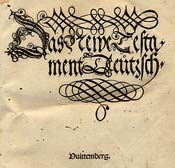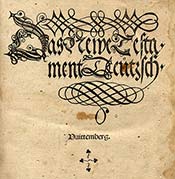The Gruber Rare Books Collection and Other Rare Books
Luther's Bible Translations - 1522
Das Neue Testament Deutzsch
The "September Testament" / "December Testament"

Title Page of the September Testament
In September, 1522, Luther published the first edition of his translation of the New Testament. He had begun that during his stay at the Wartburg, in eleven weeks from December 1521 to February 1522, but it was revised in collaboration with Melanchthon and others after he had returned to Wittenberg. Some 3-5,000 copies were printed and by December, 1522, a second edition, called the December Testament had to be published. The price was one guilder, which corresponded to two months' salary for a schoolmaster. By the time Luther published the complete Bible in 1534, 87 editions of his New Testament had been published in High German and some 19 in Low German. More than 200,000 copies had been sold.
Luther's translation was based on the second edition of the Greek text edited by Erasmus in 1519. He put Hebrews and James at the end of the testament, with Jude and Revelation, to underline what he considered as the secondary character of these books. A marginal note at Matt 5:19 refers to those who break the commandments rather than following them as "Papisten hauff" (a heap of papists). 21 illustrations from the workshop of Lucas Cranach the Elder show that the language of the book of Revelation is to be taken metaphorically. The whore of Babylon (the anti-Christ) is equated with the Pope.
"[German] philologists regard the appearance of the Luther Bibel as the greatest literary event of the sixteenth century, which exercised an almost immeasurable influence upon the development of High German." Willem Jan Kooiman, Luther and the Bible, 100.
One of the more controversial translations was Luther's rendering of Romans 3:28, where he inserted the word "alone," [a person is justified by faith alone (alleyn, in the middle of the second line in the picture below)] that was present in neither the Greek or the Latin. In his Sendbrief vom Dolmetschen [Open Letter on Translating] in 1530, Luther defended the addition of "alone" as conforming to German idiom.
Note that verse numbers had not yet been added to the biblical text.

This verse is translated in the NRSV as follows: For we hold that a person is justified by faith apart from works prescribed by the law.
The Koberger Bible read: Wan wir maynen das der mensch gerechtmachet werde durch den gelauben, on dye werck der ee.
Gruber 155 Das Newe Testament Deutsch. Vuittemberg. (Ownership: Melchior Pfaff). A copy of the September Testament of 1522.
Portrait of Luther pasted in, verso of first flyleaf. The white dots in the photograph are worm holes.
Gruber 55 Die Septemberbibel. Das Neue Testament deutsch von Martin Luther...Mit einer Einleitung von Julius Köstlein. Berlin: G. Grote'esche Verlagsbuchhandlung, MDCCCLXXXIII (1883). Facsimile of Luther's 1522 New Testament.
Gruber 32 Das Neue Testament Deutzsch. Vuittemberg. Wittenberg: Melchior Lotther, 1522 (December Testament). Two portraits laid in.
Reference
Luther's "September Bible" In Facsimile. Part I Das Newe Testament Deutzsch. Part II. Brief Historical Introduction by Kenneth A. Strand. Ann Arbor, MI: Ann Arbor Publishers, 1972. BS 2139 1522ab OVERSIZE
The Gruber Collection was assembled by L. Franklin Gruber, President of Chicago Lutheran Theological Seminary, Maywood, Illinois.
Annotation prepared by Ralph W Klein


